Managing Booth Assignments In 6 Easy Steps

Assigning booths is one of the trickiest parts of event planning. Between vendor requests, budgeting considerations, and keeping everything organized, it can feel like a puzzle with too many pieces; especially at conferences, expos, or festivals. If your event also includes ticket sales, learn how to sell tickets online in 5 easy steps.
If you’re just getting started, or if you want a smarter way to manage booth assignments, here are six practical steps to streamline the process while supporting your overall event budgeting, financial planning, and guest experience goals.
Step 1: Create a Clear Visual Floor Plan
A visual floor plan helps both you and your exhibitors understand the event layout at a glance. Start by asking your venue or city event office if they already have a template available.
From there, you can create your own using simple design tools or floor plan software. The key is to keep it clear and functional:
- Number each booth.
- Include pathways, entrances, and common areas.
- Add a legend so exhibitors know what each symbol or color means.
Pro Tip: Keep your design simple and easy to update. A polished floor plan not only saves you time but also reassures vendors that your event is well-organized.
Step 2: Share the Floor Plan with Exhibitors
Once your layout is ready, export it as an image (PNG, JPG, SVG) or PDF. Share it on your event website, exhibitor portal, or event app.
Making the floor plan accessible early reduces back-and-forth emails and helps exhibitors visualize where they’ll be located. This also helps you deliver a smoother guest experience since exhibitors can plan their displays and marketing more effectively.
Step 3: Ask for Location Preferences Upfront
When exhibitors register, give them the option to request a booth location. Adding a Preferred Booth field to your registration form makes this simple.
Just remember: unless exhibitors are paying for premium placement, treat requests as preferences, not guarantees. Be transparent about this to manage expectations.
Actionable Tip: Tie premium booth selections into your event budgeting and marketing strategy. Offering corner booths or high-traffic areas as paid upgrades can create an additional revenue stream while keeping assignments fair.
Step 4: Track Booth Assignments in Real Time
A first-come, first-served model works well for most events and motivates early registrations. The trick is staying on top of assignments as they come in.
Here’s how to stay organized:
- Assign booths immediately when registrations are received.
- Update your master floor plan regularly.
- Keep exhibitor records current with booth numbers.
This helps prevent double-booking and keeps expense tracking simple since premium spaces can be tied directly to revenue reporting in your event budgeting tool.
Step 5: Keep Your Floor Plan Updated
Decide whether you’ll publish a live version of your floor plan or keep it internal. Public versions help exhibitors see what’s still available and create urgency for late sign-ups. Private versions give you more control but may require more communication.
Pro Tip: An updated floor plan is also a valuable tool for your team’s financial planning. It quickly shows how close you are to selling out exhibitor spaces and provides insights into what areas sell fastest year over year.
Step 6: Communicate Clearly and Early
Once you’ve finalized assignments, share booth numbers with exhibitors as soon as possible. Send updates through your website, exhibitor portal, or event app, and always include the latest floor plan.
Don’t wait until every single registration is complete. Exhibitors need time to plan their setup and marketing campaigns, and timely communication improves their guest experience.
Wrapping Up: Booth Assignments Made Easier
Managing booth assignments doesn’t have to be chaotic. With a clear process and the right tools, booth assignments become less of a headache and more of an opportunity to:
- Boost event revenue. For more on balancing exhibitor income with expenses, see our guide on how to allocate event budgets.
- Strengthen exhibitor relationships.
- Create a better overall experience for attendees.
By treating booth management as part of your larger marketing strategy, financial planning, and event budgeting process, you’ll not only keep exhibitors happy but also uncover new opportunities for growth.
Frequently Asked Questions (FAQ)
How do I create a floor plan for booth assignments?
Start by checking with your venue to see if they provide a layout template. From there, you can use simple design software to mark booth numbers, pathways, and common areas. The key is clarity. Exhibitors should be able to quickly understand the layout at a glance.
What’s the best way to assign booths fairly?
Many organizers use a first-come, first-served approach since it encourages early registrations. Others allow exhibitors to pay for premium booth placements. The most important thing is to be transparent about how assignments are made so expectations are clear.
Should I publish my exhibitor floor plan online?
Yes, sharing your floor plan online is highly recommended. It helps exhibitors plan their marketing and logistics, reduces back-and-forth communication, and can even create urgency for those who haven’t booked yet.
How can booth assignments affect my event budgeting and financial planning?
Premium booth placements, sponsorships, and upgrades tied to booth selection can become significant revenue streams. Tracking these assignments alongside registrations also makes it easier to monitor income and align with your overall event budgeting and expense tracking.
When should I communicate booth assignments to exhibitors?
It’s best to communicate as soon as possible once assignments are confirmed, even if not all registrations are finalized. Early communication allows exhibitors to prepare marketing, travel, and display plans, improving their overall event experience.
